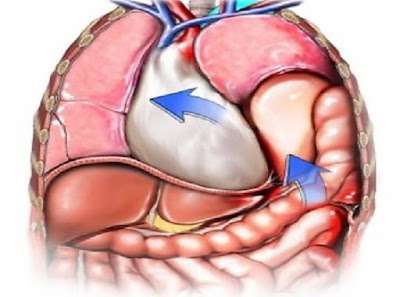What is a congenital diaphragmatic hernia?
A congenital diaphragmatic hernia is a hole in the diaphragm. The diaphragm is a flat muscle in the form of a plate. It sits between the thoracic cavity and the abdominal cavity.
Through the hole in the diaphragm to come out of the abdominal organs in the chest cavity justified. For example, the intestines and the spleen. As a result, the lungs no longer have enough space and the heart is pushed aside.
A congenital diaphragmatic hernia is very serious. Most children immediately after birth trouble breathing. This is because the lungs do not have enough space to work properly. Moreover, the lungs during pregnancy has not grown enough. The abdominal organs were also already then in the way.
Most babies need resuscitation at birth. The baby will be operated as soon as possible. In the operation, the surgeon brings the bodies back in the abdomen, and connect them to the diaphragm.
In the Netherlands, every year about sixty children born with a diaphragmatic hernia. About three out of four children survive the hiatus hernia and surgery.
The medical name for congenital diaphragmatic hernia is congenital diagfragmatica hernia (CDH).
A congenital diaphragmatic hernia is different from a diaphragmatic hernia in adults. For information about a diaphragmatic hernia in adults, please contact the Digestive Diseases Foundation.
Congenital diaphragmatic hernia symptoms
Most children born with a diaphragmatic hernia directly very stuffy. They are blue or pale rapidly after birth. A child can also have the following symptoms:
- The belly is concave rather than convex.
- The heart is on the right of the sternum.
- The breath is only to hear one side of the chest.
Doctors often detect even before birth that a child has a diaphragmatic hernia. During the show they echo the heart, lungs and / or abdominal organs are not in the right place.
The consequences of a diaphragm rupture
After successful treatment of congenital diaphragmatic hernia, a child can still keep some complaints.
- Intensive ventilation sometimes damages the lungs, especially in small babies. A child can thus still a time keeping problems with the lungs and the breathing. Usually recover within two years from the lungs altogether. The child can resume normal life and example just participate in sport.
- The child has little energy and quickly become exhausted by drinking or other physical exertion. This can lead to feeding problems. Sometimes it is necessary tube feeding. Due to the lack of energy to start some children later with things like crawling and walking. Usually the lung complaints within two years and the lack of energy also.
- The first two years, some children suffer from vomiting and rising acid (reflux). Here they are medicated against. Rarely, surgery is needed.
- There is a chance that the diaphragm fracture after the operation comes back again. This occurs at approximately seven hundred of the children with a small fraction. In a very large rupture is more likely: the diaphragmatic hernia can come back at forty of the hundred children.

